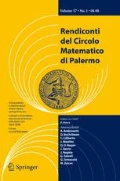Abstract
In this note, we show that the classical Fibonacci and Lucas sequence do not contain any perfect number.
Similar content being viewed by others
References
Cohn J.H.E.,Square Fibonacci numbers, etc., Fibo. Quart.,2 (1964).
Dickson L.E.,History of the Theory of Numbers, Vol. I, Divisiblity and Primality, Chelsea Publishing Company, New York, 1966.
Luca F.,Euler Indicators of Lucas Sequences, Bull. Math. Soc. Sc. Mat. Roumanie, Tome40 (88) (1997), 151–163.
Luca F.,Arithmetic functions of Fibonacci and Lucas numbers, Fibo. Quart.,37 (1999), 265–268.
Ribenboim P.,Square Classes of Fibonacci and Lucas numbers, Portugaliae Math.46 (1) (1989), 159–176.
Robbins N.,On Fibonacci numbers of the form px 2 where p is a prime, Fibo. Quart.21 (1983), 266–271.
Rosen K.H.,Elementary number theory and its applications, Addison-Wesley, 1984.


